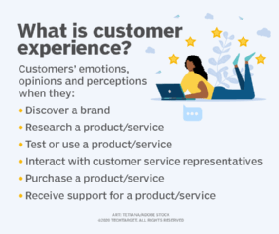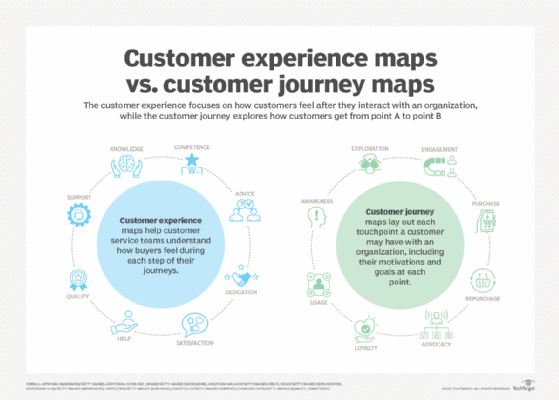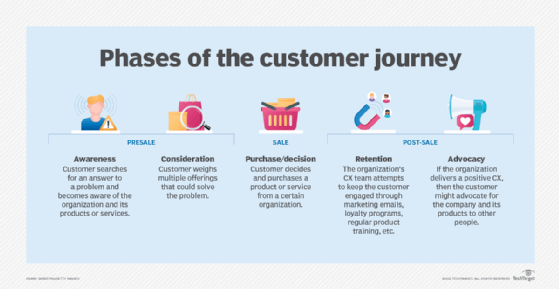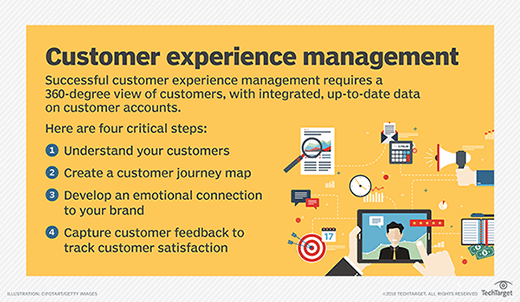What is customer experience (CX) and why is it important? (original) (raw)
Customer experience (CX) is the sum total of customers' perceptions and feelings resulting from interactions with a brand's products and services. CX spans the lifetime of customers' relationships with a brand, starting before a purchase is made, continuing through active use and to renewal or repeat purchase.
Any brand that has customers provides a customer experience whether the brand realizes it or not. As the term implies, CX is based on the perceptions and opinions of customers. A brand might claim to sell a superior product or provide outstanding customer service, but customers are the ultimate arbiter.
Customer experience can be hard for brands to control because customers act, respond and react in unpredictable ways. The best approach for brands is to assess and optimize each customer touchpoint, or interaction, to maximize the likelihood of customer satisfaction.
How customer experience works
Customer experience encompasses all the touchpoints customers have with a brand. Examples of touchpoints include researching product offerings, buying the product online or in person, opening a product's packaging, reading the instruction manual, speaking to a customer service agent, having the product repaired and exchanging the product for a different model.
Customers experience feelings and emotions at each touchpoint, which causes them to form judgments. Feelings can range from joy to apathy, disappointment and even anger. Judgments can range from positive, such as viewing the company as helpful when a customer is efficiently assisted, to negative, such as seeing the company as incompetent when dealing with slow and frustrating customer service. The emotions and judgments can vary wildly from one touchpoint to the next.
A positive CX can lead to customer retention. Gartner research in 2020 found an 82% average probability that a customer would stay with an organization when given the opportunity to switch after a value-enhancing service interaction compared with 61% probability after a regular interaction.

Customer experience considers how customers discover a brand and interact with customer service representatives among others.
Importance of customer experience
Great customer experience is one of the most important factors for business success. Brands that provide a poor customer experience take a hit financially and, in some cases, don't survive.
Providing excellent CX results in satisfied customers who become loyal customers who do repeat business. This is a more effective way to grow a business than relying solely on generating new customers. Many brands use CX as a competitive advantage, increasing market share by providing a superior customer experience compared to competitors.
Happy customers can also become brand ambassadors. These are advocates who recommend a business's products and services to friends, associates and colleagues via word of mouth and social media.
How does CX improve sales?
Customer experience can have a significant impact on driving sales and improving a company's bottom line. Organizations that provide a great CX can boost sales revenue by 2% to 7% and improve profitability by 1% to 2%. This growth is one of the benefits of a positive customer experience.
Strong CX often leads to increased customer satisfaction and loyalty. Satisfied customers are more likely to make repeat purchases, upgrade to premium offerings and remain loyal over an extended period of time. This loyalty translates to higher customer lifetime value (CLV), as these individuals contribute more revenue to the business compared to dissatisfied or disengaged customers. This can increase cross-sell rates, the practice of selling additional products to existing customers, by 15% to 25%. It also increases a company's share of wallet -- the amount of money a customer regularly spends on a brand's particular product versus competing brands' similar products.
Another way CX can improve sales is through word-of-mouth marketing and brand advocacy. Customers who have positive experiences are more likely to become enthusiastic brand advocates, sharing their experiences with friends and family and on social media platforms.
How to improve customer experience
Creating great CX requires a customer-centric approach, as well as a deep understanding of customer needs and expectations. Key initiatives to improving CX include the following.
Develop a customer experience strategy
A well-defined CX strategy serves as a roadmap for delivering exceptional customer interactions. It involves understanding the target audience, defining a brand promise and aligning business goals with customer expectations. A CX strategy should guide all customer-facing interactions and initiatives.
Embrace digital transformation
Digital transformation enables businesses to deliver personalized, real-time digital experiences that cater to customers' preferences and needs. This includes providing seamless omnichannel experiences, optimizing websites and mobile apps for user experience, and using new technologies, such as artificial intelligence (AI), to enhance self-service options.
Empower employees
Employees can provide the best and most personalized support when they're equipped with the necessary tools, training and authority to resolve customer issues. Empowered employees feel valued and motivated, leading to positive interactions with customers and, ultimately, enhancing customer experience.
Understand the customer journey
Customer journey mapping helps businesses understand end-to-end CX and identify pain points and areas for improvement. By mapping each touchpoint and customer interaction, businesses gain insight into critical customer interactions and make informed decisions to enhance the experience. Additionally, customer journey mapping details a customer's goals and motivations at each one of those touchpoints.

Both customer experience maps and customer journey maps focus on customers' interactions with an organization. A journey map details each customer touchpoint, while an experience map details how customers feel during each step of those interactions.
Personalize customer interactions
Personalization is key to driving customer engagement and creating great CX. Using customer data and insights, businesses can tailor their interactions to meet individual preferences and needs. Personalization can range from addressing customers by their names to offering personalized recommendations based on their past purchases and preferences.
Foster a customer-centric culture
Creating a customer-centric culture starts from the top and permeates throughout the organization. It involves ensuring that every employee understands the importance of customer experience and is committed to delivering exceptional customer service. A culture of customer centricity encourages collaboration, innovation and accountability in interacting with customers.
Monitor and adapt
Customer expectations and preferences evolve over time, so organizations must continuously monitor and adapt their CX initiatives. They should regularly review customer feedback on websites and social media, analyze customer behavior and stay updated on industry trends to identify areas for improvement and innovation. Customer feedback is essential to business, and companies should be willing to make changes to align with customer needs.
Use technology and automation
The latest technologies and automation can streamline processes, reduce customer effort and enhance overall CX. Implementing self-service options, chatbots and AI-powered tools can provide quick and efficient answers to customer queries and improve response times. However, it's essential to strike a balance between automation and human touch to maintain a personalized experience.
Encourage customer advocacy
The most successful customer experiences can turn customers into brand ambassadors and advocates. Organizations should encourage and incentivize customers to share their positive experiences through testimonials, online reviews and word-of-mouth recommendations. Customer advocacy can significantly impact brand reputation and attract new customers.
Customer experience vs. customer service
Customer experience and customer service are similar, related terms, but they aren't interchangeable. Customer service is a facet of customer experience that requires specific customer-related skills, while customer experience refers to a broader spectrum of the customer journey.
Customer experience describes the emotions, judgments and reactions that a customer has throughout the process of interacting with the business. These steps include researching the product, making the purchase, getting help when there's a problem, reviewing the product and service, and potentially recommending it to others.
Customer service, on the other hand, is limited to interactions a customer has with a business's employees -- often customer support representatives -- before, during and after a purchase. These interactions can occur through communication channels, such as live chat, social media, phone calls, chatbots and email. Customer service can focus on helping a customer choose the right product and troubleshoot problems.
Customer experience vs. employee experience
Customer experience and employee experience (EX) are similar terms that can both affect an organization's bottom line. While CX deals solely with the customer's experience, EX deals with employees' experience, engagement and satisfaction working for a company.
According to some studies, companies with strong employee engagement perform significantly better than their competition. In addition, employees working for organizations with successful customer experience often consider themselves more engaged than employees at companies with poor or average CX.
Who is responsible for CX?
Customer experience is a collective responsibility that extends across an entire organization. While various roles contribute to CX, the commitment of top leadership is crucial for driving it. In particular, the chief executive officer plays an important role in prioritizing CX initiatives. However, there are other C-suite executives and department heads who also have important responsibilities in shaping CX. The most important include the following:
- Chief experience officer. The CXO oversees the overall customer experience strategy, working across departments to ensure a streamlined and successful customer journey.
- Chief marketing officer. The CMO is responsible for tailoring customer communications, managing customer insights and creating a cohesive brand experience.
- Customer experience manager. This executive is responsible for enhancing customer touchpoints, managing customer service teams and implementing customer-centric strategies.
Collaboration across departments is essential for CX success. To foster a customer-centric culture, organizations should set common CX metrics and targets for the entire organization, provide all teams with access to customer insights and relevant data and help teams understand the customer journey and its contributions to the overall CX experience.
How the customer journey works
The customer journey encompasses the steps a person takes to become and remain a customer. It represents a customer's end-to-end experience with a business or organization, extending beyond individual transactions or touchpoints. The customer journey has five major steps:
- Becoming aware of a product or service
- Considering a purchase.
- Buying the product or service.
- Having repeated dealings with the business and becoming a loyal customer.
- Becoming an advocate for the product and brand.
Customer journeys involve multiple touchpoints, including website visits, ad clicks, sale interactions, brick-and-mortar visits, social media engagements, support requests and billing. These touchpoints can occur before, during or after a customer experiences a product or service. For example, onboarding a new customer might involve numerous interactions across various channels over several months.

There are five major steps in the customer journey, from awareness to advocacy.
Customer experience management (CXM)
Companies can use processes to track, oversee and organize customer touchpoints through CXM. With CXM, the organization can evaluate and improve every interaction between a customer and the company throughout the customer lifecycle.
In a small business dependent on in-store purchases -- such as a bakery, produce market or dry cleaner -- only a few individuals provide customer experience. In larger companies that sell complex products and services, numerous groups and departments contribute to CX, some directly and others indirectly. Sales and customer support interact directly with customers. Other groups, such as engineering, marketing, finance and legal, create products, services and processes that affect and influence customers, but they might not interact directly with them.
For more complex products and businesses, excellent customer service requires close coordination across groups among other customer service best practices. For example, sales and customer support can provide customer feedback to product engineers so they can consider creating a new feature to address a product deficiency. Engineering then coordinates with marketing, which takes the lead in developing messaging about the new feature and communicating it to the market. Without such coordination, the product's shortcomings would go unaddressed or any fixes uncommunicated, perpetuating a poor customer experience.

Successful customer experience management involves four basic steps and begins with understanding the customer.
Examples of good customer experience
Positive customer experience often revolves around listening to customer feedback and taking action on it. The following are some examples of CX strategies:
- Netflix' personalization strategies. Personalization provides customers with content and other marketing materials based on their individual preferences and past behaviors. Netflix uses personalization techniques to offer customers goods and services that they're likely to be interested in. This approach improves CX, boosts sales, and enhances brand and customer loyalty. The company's personalization engine recommends media content that it predicts a customer will enjoy based on past consumption and any rating feedback the customer provides; these predictions increase in accuracy as a customer consumes more content and provides more ratings.
- Microsoft's customer feedback collection. When companies listen to their customers' thoughts and feelings about a product or service, they're able to respond to that feedback positively. Companies can collect customer feedback by deploying post-interaction and post-purchase surveys, listening to recorded phone calls, using analytics tools, and looking at social media and other digital channels. Microsoft uses such customer feedback forums to get suggestions from customers and let them vote on their favorite feature ideas.
- Chewy's emotional connections. Customers are more likely to engage with brands that they have emotional connections to. To spark this connection, companies identify their customers' emotional motivators, such as the desire to feel successful or unique or a sense of belonging. For example, the e-commerce pet supply company Chewy is known for sending flowers and handwritten cards when a customer's pet dies, which fosters trust and loyalty.
Causes of bad customer experience
The quality of a customer's experience can be a key differentiator in a company's CX success. Take the example of a company that sells an innovative, award-winning product. However, when customers ask for assistance, their calls aren't returned, and their issues go unresolved. In this example, the poor quality of customer service defines customer experience, undercutting the value of the company's innovative product.
CX strategies fail because of a variety of factors, such as the following:
- Lack of alignment across the organization. Achieving good CX requires coordination among a variety of departments. All team members should understand and be working toward the same CX goals. For example, a customer support team can be fully invested in CX, but if the sales team isn't, then customers are likely not to be buying in the product or service.
- Unclear customer journey. Mapping out the customer journey lets CX teams identify pain points and the factors that influence a customer to make a purchase. Without an understanding of the customer journey, it's difficult for an organization to connect with its customers at the right time using the appropriate communication channels.
- Lack of technology. CX technologies enable an organization to collect the right data, measure customer satisfaction and organize customer information. Without these tools, brands can struggle to effectively deliver a positive experience.
Measuring CX
There are a variety of metrics to measure customer experience. The most effective include the following:
- Net promoter score (NPS). This is one of the most common CX metrics. NPS measures brand loyalty through one question: How likely is it that you would recommend this company, product or service to a friend? Customers give a 0-10 rating, which corresponds to not at all likely to extremely likely. To calculate an overall NPS score, eliminate the neutral responses, and subtract the percentage of detractors from the percentage of promoters.
- Customer satisfaction. A CSAT score is another common metric that's gauged through the question: How would you rate your overall satisfaction with the product or service? Customers respond with a 1-5 rating; 1 represents very unsatisfied, and 5 represents very satisfied.
- Customer churn rate. This metric measures the rate of repeat customers. There are a variety of ways to calculate customer churn, such as using the number of lost subscribers or monthly recurring revenue. A good churn rate depends on many factors, such as the company's industry and location.
- Customer effort score (CES). This measures the ease of customer experience, and the effort required to resolve any issues. CES is calculated using responses to customer feedback surveys.
- Voice of the customer (VOC). Collecting this feedback directly from customers through surveys, interviews and online reviews provides valuable insights into their experiences and expectations. Analyzing VOC feedback helps businesses understand customer sentiment and make data-driven improvements.
- Customer lifetime value. This metric measures the total revenue a customer generates over their entire relationship with the company. By understanding CLV, businesses can focus on retaining high-value customers and enhancing their experience.
Customer experience management vendors and tools
It can be helpful for brands to assess the overall customer experience they provide through CXM. Companies can use several techniques and technologies, such as the following:
- Customer relationship management (CRM) platforms organize and consolidate customer information into a single database. Most CRM platforms include functions such as marketing automation, lead management and workflow automation. Major CRM vendors include Microsoft, Oracle, Salesforce and SAP.
- Customer data platforms (CDPs) enable organizations to analyze user data and build detailed customer profiles. Customer analytics tools are often a feature of CDPs, which are sold as part of CRM systems or on their own. Vendors selling CDP tools include Bloomreach, BlueConic, Blueshift, Emarsys, Optimove, Tealium, Treasure Data and Twilo.
- Contact center software helps organizations monitor customer calls and other interactions. It also lets businesses analyze customer conversations and sentiment. Contact center software vendors include Amazon, Avaya, CloudTalk, Dialpad, Five9, Google, Microsoft, Nextiva, Nice, Salesforce, Vonage and Zoom.
Customer experience plays a part in retaining customers and driving revenue and profit. Master the top 10 customer success key performance indicators and metrics you should be tracking.